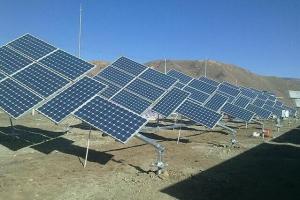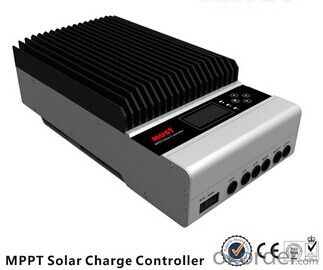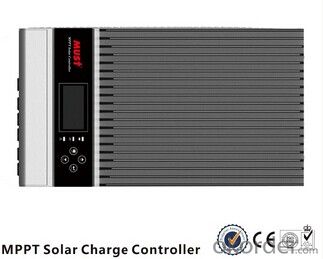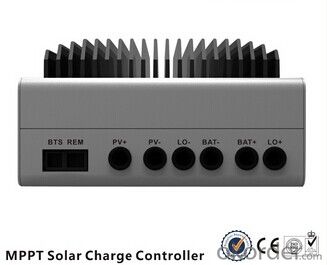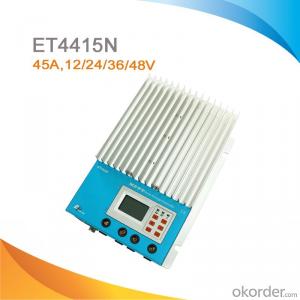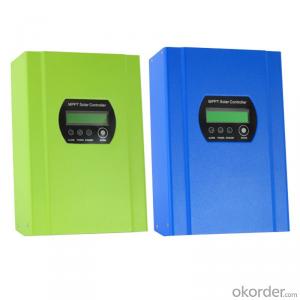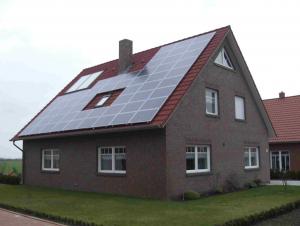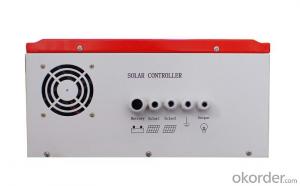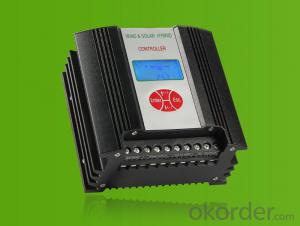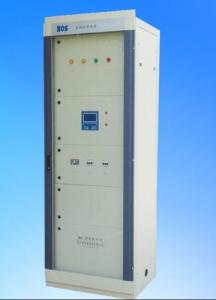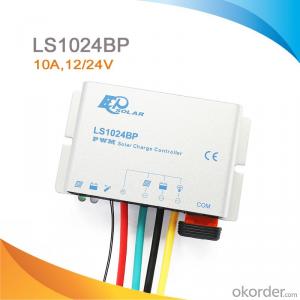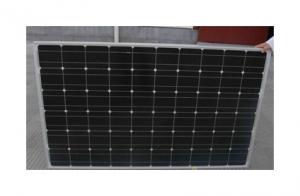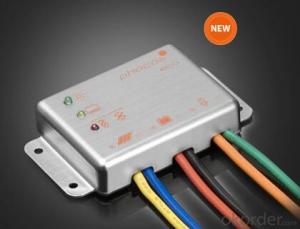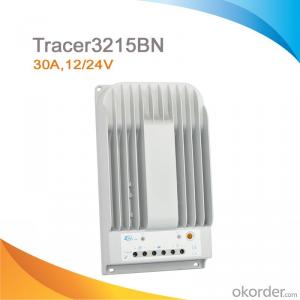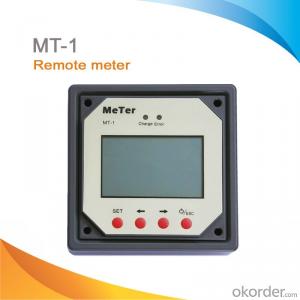Windy Nation MPPT Electronic Controller High Efficiency 45A Good Quality Solar Controllers
- Loading Port:
- Shekou
- Payment Terms:
- TT or LC
- Min Order Qty:
- 100 pc
- Supply Capability:
- 100000 pc/month
OKorder Service Pledge
OKorder Financial Service
You Might Also Like
MPPT Electronic Controller High Efficiency 45A
1. MPPT Solar Charger Controller Characteristics:
1. MPPT Solar charge controller 20A,30A,40A
2. MPPT efficiency max 99%,Peak conversion efficiency >98%
3.PV input :100V or 145V max
4.12v/24v auto work
5.DSP processors architecture ensures high speed and performance
6.Four stages charging method
7.Protection :PV arry short circuit ,PV reverse polarity ,battery reverse polarity,over charging ,output short circuit.
2. MPPT Electronic Controller specifications:
| Model | PC16-4515A | PC16-6015A | |
| Default Battery System Voltage | 12V/24V/36V/48VDC (adjustable) | ||
| CONTROLLER INPUT | PV Open Circuit Voltage Range | 16V~100V for 12V battery system/32V~145V for 24V battery system/ 48V~145V for 36V battery system/64V~145V for 48V battery system | |
| Max PV Input Power(12V) | 600W | 800W | |
| Max PV Input Power(24V) | 1200W | 1600W | |
| Max PV Input Power(36V) | 1800W | 2400W | |
| Max PV Input Power(48V) | 2400W | 3200W | |
| BATTERY | Limited charge voltage | 15.5~16.0VDC/31.0~32.0VDC/46.5~48.0VDC/62.0~64.0VDC | |
| Equalizing charge voltage | 15.0~15.5VDC/30.0~31.0VDC/45.0~46.5VDC/60.0~62.0VDC | ||
| Boost charge voltage | 14.0~15.0VDC/28.0~30.0VDC/42.0~45.0VDC/56.0~60.0VDC | ||
| Float charge voltage | 13.2~14.0VDC/26.4~28.0VDC/39.6~42.0VDC/52.8~56.0VDC | ||
| Equalizing charge interval | 3~30day | ||
| Equalizing charge time | 1H~3H | ||
| Boost charge time | 1H~3H | ||
| DC OUTPUT | Output Voltage | 9.8~16.0VDC/19.6~32.0VDC/29.4~48.0VDC/ 39.2~64.0VDC | |
| Peak Conversion Efficiency | 98% (MPPT Efficiency 99%) | ||
| Max Charging Current | 45A | 60A | |
| Warning for low voltage | 11.8VDC/23.6VDC/35.4VDC/47.2VDC(Adjustable) | ||
| Cutoff for low voltage | 9.8VDC/19.6 VDC/29.4VDC/39.2VDC(Adjustable) | ||
| Low voltage recovery | 12.0~13.0VDC/24.0~26.0 VDC/36.0~39.0VDC/48.0~52.0VDC(Adjustable) | ||
| GENERAL SPECIFICATION | Charge mode | MPPT, PWM, constant current-constant voltage, function of automatic protection for storage battery | |
| Radiating mode | Air cooling | ||
| Working mode | Four stage: Absorption CC, Absorption CV, Float CC, Float CV | ||
| Light controlled open voltage | 5V | ||
| Light controlled delay time | 5min | ||
| DISPLAY & PROTECTION | LED indication | Systematic operation, LV indication, LV protection, over charge protection, loads protection, short circuit protection | |
| LCD display | Charge voltage, charge current, voltage of storage battery, capacity of storage battery, output current | ||
| Alarm Protections | PV array short circuit, PV reverser polarity | ||
| Battery reverse polarity, Over charging protection | |||
| Output short circuit protection | |||
| Low voltage protection for storage battery | |||
| MECHANICAL SPECIFICATIONS | Mounting | Wall mount | |
| W*H* D(mm)/G.W(kg) | 170*259*128mm/4.2kg | 170*289*128mm/4.8kg | |
| OTHER | Environmental Rating | Indoor | |
| Operation Temperature Range | -35~45°C | ||
| Ambient humidity | 0~90% relative humidity(non-condensing) | ||
| Altitude | ≤3000m | ||
3. MPPT Solar Charger Controller Production Line:
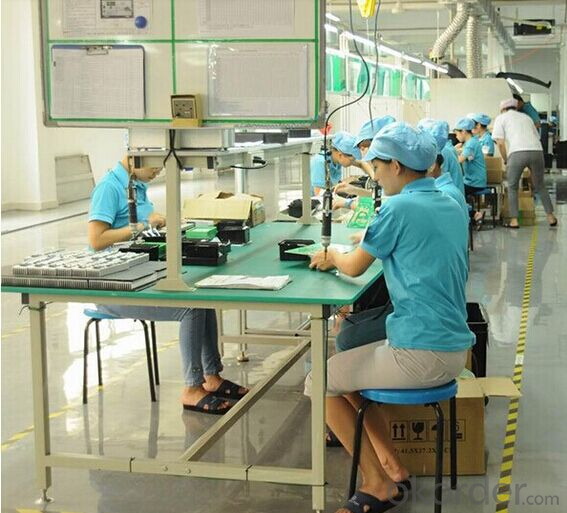
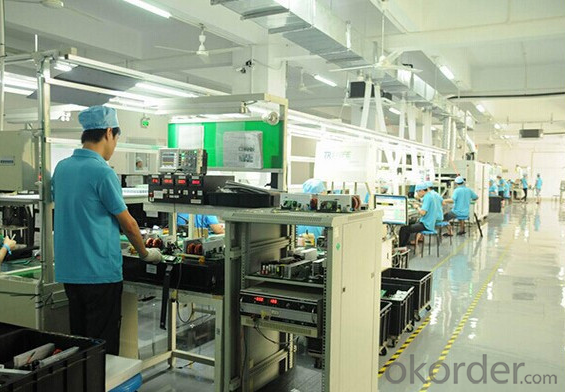
4. MPPT Solar Charger Controller FAQ:
We have organized several common questions for our clients, may help you sincerely:
1. How to choose a right solar controller?
Tell us your demand, then our sales will recommend a suitable one to you.
2. What is the solar inverter warranty?
Our product warranty is valid for 12 months after delivery. We undertake to repair any malfunctioned units due to defective components of inadequate workmanship ,but specially expecting any defects resulting from normal wear and tear of improper use of the products.
3. How long can we receive the product after purchase?
a.sample orders will be delivered from our factory within 7working days .
b.General orders(under 2000pcs) will be delivered from our factory within 25 working days.
c. Bulk orders (over 2000pcs )will be delivered from our factory within 35 working days at most
4. What is the payment term?
T/T (Telegraphic transfer) / Letter of credit
- Q: Are there any safety precautions I should take when using a solar controller?
- Yes, there are a few safety precautions to take when using a solar controller. 1. Familiarize yourself with the product's user manual and instructions before installation or operation. This will help you understand the specific safety guidelines provided by the manufacturer. 2. Ensure that the solar controller is properly installed and connected according to the instructions provided. This includes the correct wiring and grounding procedures. 3. Avoid contact with any live electrical components while installing, operating, or maintaining the solar controller. Always turn off the power source and wear appropriate protective gear, such as insulated gloves, when necessary. 4. Regularly inspect the solar controller for any signs of damage, wear, or loose connections. If any issues are detected, promptly disconnect the power source and consult a professional for repairs or replacements. 5. Do not expose the solar controller to extreme temperatures, moisture, or direct sunlight, as it can affect its performance and durability. Install it in a well-ventilated and protected area, if possible. 6. In case of any abnormal behavior, such as unusual noises, smoke, or sparks, immediately disconnect the power source and contact a qualified technician for assistance. Remember, while solar controllers are generally safe to use, it is essential to prioritize safety precautions to minimize potential risks and ensure the optimal performance of your system.
- Q: Can a solar controller be used with a solar lighting system?
- Yes, a solar controller can be used with a solar lighting system. A solar controller regulates the flow of energy from the solar panels to the lighting system, ensuring optimal charging and preventing overcharging or damage to the batteries. It helps control the charging process and extends the lifespan of the batteries, making it an essential component for a reliable and efficient solar lighting system.
- Q: What is the compatibility of a solar controller with other components?
- The compatibility of a solar controller with other components refers to its ability to effectively work together with other devices in a solar power system. This includes compatibility with solar panels, batteries, inverters, and other equipment. It is essential for a solar controller to be compatible with these components to ensure optimal performance, efficient energy conversion, and reliable operation of the entire system.
- Q: What is the maximum load power that a solar controller can handle?
- The maximum load power that a solar controller can handle depends on the specific model and capacity of the controller. It can range from a few hundred watts to several thousand watts. It is important to consult the manufacturer's specifications or consult with a professional to determine the exact maximum load power for a particular solar controller.
- Q: Can a solar controller be used with a solar-powered air purifier?
- Yes, a solar controller can be used with a solar-powered air purifier. A solar controller is designed to regulate the voltage and current from the solar panels, ensuring optimal charging of the battery or powering the device directly. In the case of a solar-powered air purifier, the solar controller can effectively manage the energy flow from the solar panels to the air purifier, enabling its operation even in low-light conditions while maximizing the energy efficiency of the system.
- Q: Can a solar controller be used with solar panel tracking algorithms?
- A solar panel tracking algorithm can be utilized in conjunction with a solar controller. The solar controller's role is to manage and regulate the power flow between the solar panels and the batteries or electrical loads. It ensures that the solar panels are functioning at their utmost efficiency and prevents the batteries from experiencing overcharging or over-discharging. On the other hand, solar panel tracking algorithms are employed to optimize the positioning of the solar panels in order to maximize sunlight absorption throughout the day. These algorithms calculate the sun's position and adjust the tilt and orientation of the solar panels accordingly. By integrating a solar controller with solar panel tracking algorithms, the system becomes more efficient and effective. The solar controller can receive input from the tracking algorithms to modify the power flow based on the real-time position of the sun. Consequently, the solar panels can operate continuously at their optimal angle, resulting in increased energy production. Additionally, the solar controller can provide feedback to the tracking algorithms by monitoring the power output of the solar panels. If any issues arise, such as a decrease in output due to shading or malfunctioning panels, the controller can notify the tracking algorithms to make necessary adjustments. In conclusion, by combining a solar controller with solar panel tracking algorithms, the overall performance and energy production of the solar system can be significantly enhanced.
- Q: How does a solar controller handle voltage fluctuations from the solar panels?
- A solar controller or charge controller is a device used in solar power systems to regulate and control the flow of electricity between the solar panels and the battery bank. One of the key functions of a solar controller is to handle voltage fluctuations from the solar panels. When sunlight strikes the solar panels, it generates direct current (DC) electricity. However, the voltage output of solar panels can vary depending on factors such as the intensity of sunlight, temperature, and shading. These voltage fluctuations can be harmful to the battery bank as they can overcharge or undercharge the batteries, leading to reduced battery lifespan and performance. To handle voltage fluctuations, a solar controller employs a technique called Maximum Power Point Tracking (MPPT). MPPT is a technology that ensures the solar panels operate at their maximum power output, regardless of the fluctuations in voltage. The solar controller continuously monitors the voltage and current from the solar panels and tracks the optimal operating point, where the panels produce the most power. By constantly adjusting the electrical load on the panels, the MPPT algorithm ensures that the panels operate at their maximum power output, even when the voltage fluctuates. The solar controller achieves this by dynamically adjusting the resistance across the panels, thereby optimizing the voltage and current levels. This allows the solar panels to consistently deliver a stable and optimal voltage to the battery bank, regardless of any fluctuations in the environment. In addition to MPPT, solar controllers also incorporate various protective features to handle voltage fluctuations. These features include overcharge protection, which prevents the batteries from being overcharged when the solar panels produce excessive voltage, and over-discharge protection, which prevents the batteries from being excessively discharged when the solar panels produce insufficient voltage. Overall, a solar controller plays a crucial role in handling voltage fluctuations from the solar panels. By utilizing MPPT technology and incorporating protective features, it ensures that the solar power system operates efficiently, maximizing the power output from the panels while safeguarding the battery bank from damage caused by voltage fluctuations.
- Q: Can a solar controller be used with a solar-powered gate opener?
- Yes, a solar controller can be used with a solar-powered gate opener. The solar controller helps regulate and optimize the charging of the batteries connected to the gate opener, ensuring efficient and reliable operation of the gate system.
- Q: How does a solar controller handle power fluctuations from the solar panels?
- A solar controller, also known as a charge controller, is a crucial component in a solar power system that manages the power fluctuations from the solar panels. Its primary function is to regulate and control the charging process of the batteries and prevent them from overcharging or undercharging. When it comes to power fluctuations from the solar panels, the solar controller employs various techniques to handle them effectively. One of the primary methods is the use of maximum power point tracking (MPPT) technology. MPPT allows the solar controller to constantly monitor the voltage and current output of the solar panels and adjust the charging parameters accordingly. During power fluctuations, the solar controller continuously tracks the maximum power point of the solar panels, which is the point at which they generate the most power. By doing so, it ensures that the solar panels are operating at their optimal efficiency, regardless of any fluctuations in sunlight intensity, temperature, or shading. This MPPT feature enables the solar controller to extract the maximum available power from the solar panels and deliver it to the batteries. Furthermore, a solar controller also incorporates various protection mechanisms to handle power fluctuations. It typically includes features like overvoltage protection, low voltage disconnect, and short circuit protection. These safety measures safeguard the solar panels, batteries, and other components of the system from potential damage caused by voltage spikes, sudden drops in voltage, or electrical faults. In addition to MPPT and protective features, some advanced solar controllers also offer advanced algorithms and programming options. These allow the controller to dynamically adjust the charging parameters based on the solar panel's performance, battery condition, and system requirements. This adaptability ensures efficient power management and optimal battery charging, even in the face of power fluctuations. Overall, a solar controller is designed to handle power fluctuations from the solar panels by utilizing MPPT technology, implementing protective measures, and employing advanced algorithms. Its role is to ensure the smooth and efficient operation of the solar power system, maximize power generation, and prolong the lifespan of the batteries.
- Q: What is the maximum voltage and current rating for a solar controller?
- The specific model and manufacturer of a solar controller can cause variations in its maximum voltage and current rating. Generally, solar controllers are capable of handling voltage ratings up to 150 volts or even higher. In terms of current ratings, they can typically manage currents of 60 amps or more. It is essential to recognize that these ratings can vary depending on the design and capabilities of the solar controller. As a result, it is vital to consult the manufacturer's specifications or user manual to determine the precise maximum voltage and current rating for a specific solar controller model.
Send your message to us
Windy Nation MPPT Electronic Controller High Efficiency 45A Good Quality Solar Controllers
- Loading Port:
- Shekou
- Payment Terms:
- TT or LC
- Min Order Qty:
- 100 pc
- Supply Capability:
- 100000 pc/month
OKorder Service Pledge
OKorder Financial Service
Similar products
Hot products
Hot Searches
Related keywords
